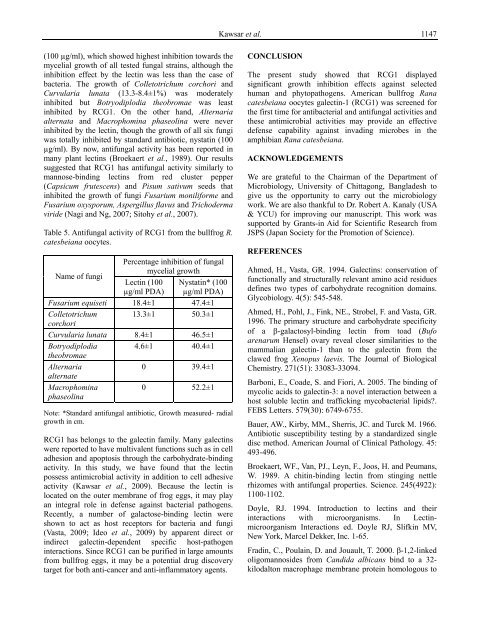Download (5Mb) - Covenant University Repository
Download (5Mb) - Covenant University Repository
Download (5Mb) - Covenant University Repository
Create successful ePaper yourself
Turn your PDF publications into a flip-book with our unique Google optimized e-Paper software.
(100 µg/ml), which showed highest inhibition towards the<br />
mycelial growth of all tested fungal strains, although the<br />
inhibition effect by the lectin was less than the case of<br />
bacteria. The growth of Colletotrichum corchori and<br />
Curvularia lunata (13.3-8.4±1%) was moderately<br />
inhibited but Botryodiplodia theobromae was least<br />
inhibited by RCG1. On the other hand, Alternaria<br />
alternata and Macrophomina phaseolina were never<br />
inhibited by the lectin, though the growth of all six fungi<br />
was totally inhibited by standard antibiotic, nystatin (100<br />
µg/ml). By now, antifungal activity has been reported in<br />
many plant lectins (Broekaert et al., 1989). Our results<br />
suggested that RCG1 has antifungal activity similarly to<br />
mannose-binding lectins from red cluster pepper<br />
(Capsicum frutescens) and Pisum sativum seeds that<br />
inhibited the growth of fungi Fusarium moniliforme and<br />
Fusarium oxysporum, Aspergillus flavus and Trichoderma<br />
viride (Nagi and Ng, 2007; Sitohy et al., 2007).<br />
Table 5. Antifungal activity of RCG1 from the bullfrog R.<br />
catesbeiana oocytes.<br />
Name of fungi<br />
Percentage inhibition of fungal<br />
mycelial growth<br />
Lectin (100 Nystatin* (100<br />
µg/ml PDA) µg/ml PDA)<br />
Fusarium equiseti 18.4±1 47.4±1<br />
Colletotrichum<br />
corchori<br />
13.3±1 50.3±1<br />
Curvularia lunata 8.4±1 46.5±1<br />
Botryodiplodia<br />
theobromae<br />
4.6±1 40.4±1<br />
Alternaria<br />
alternate<br />
0 39.4±1<br />
Macrophomina<br />
phaseolina<br />
0 52.2±1<br />
Note: *Standard antifungal antibiotic, Growth measured- radial<br />
growth in cm.<br />
RCG1 has belongs to the galectin family. Many galectins<br />
were reported to have multivalent functions such as in cell<br />
adhesion and apoptosis through the carbohydrate-binding<br />
activity. In this study, we have found that the lectin<br />
possess antimicrobial activity in addition to cell adhesive<br />
activity (Kawsar et al., 2009). Because the lectin is<br />
located on the outer membrane of frog eggs, it may play<br />
an integral role in defense against bacterial pathogens.<br />
Recently, a number of galactose-binding lectin were<br />
shown to act as host receptors for bacteria and fungi<br />
(Vasta, 2009; Ideo et al., 2009) by apparent direct or<br />
indirect galectin-dependent specific host-pathogen<br />
interactions. Since RCG1 can be purified in large amounts<br />
from bullfrog eggs, it may be a potential drug discovery<br />
target for both anti-cancer and anti-inflammatory agents.<br />
Kawsar et al. 1147<br />
CONCLUSION<br />
The present study showed that RCG1 displayed<br />
significant growth inhibition effects against selected<br />
human and phytopathogens. American bullfrog Rana<br />
catesbeiana oocytes galectin-1 (RCG1) was screened for<br />
the first time for antibacterial and antifungal activities and<br />
these antimicrobial activities may provide an effective<br />
defense capability against invading microbes in the<br />
amphibian Rana catesbeiana.<br />
ACKNOWLEDGEMENTS<br />
We are grateful to the Chairman of the Department of<br />
Microbiology, <strong>University</strong> of Chittagong, Bangladesh to<br />
give us the opportunity to carry out the microbiology<br />
work. We are also thankful to Dr. Robert A. Kanaly (USA<br />
& YCU) for improving our manuscript. This work was<br />
supported by Grants-in Aid for Scientific Research from<br />
JSPS (Japan Society for the Promotion of Science).<br />
REFERENCES<br />
Ahmed, H., Vasta, GR. 1994. Galectins: conservation of<br />
functionally and structurally relevant amino acid residues<br />
defines two types of carbohydrate recognition domains.<br />
Glycobiology. 4(5): 545-548.<br />
Ahmed, H., Pohl, J., Fink, NE., Strobel, F. and Vasta, GR.<br />
1996. The primary structure and carbohydrate specificity<br />
of a β-galactosyl-binding lectin from toad (Bufo<br />
arenarum Hensel) ovary reveal closer similarities to the<br />
mammalian galectin-1 than to the galectin from the<br />
clawed frog Xenopus laevis. The Journal of Biological<br />
Chemistry. 271(51): 33083-33094.<br />
Barboni, E., Coade, S. and Fiori, A. 2005. The binding of<br />
mycolic acids to galectin-3: a novel interaction between a<br />
host soluble lectin and trafficking mycobacterial lipids?.<br />
FEBS Letters. 579(30): 6749-6755.<br />
Bauer, AW., Kirby, MM., Sherris, JC. and Turck M. 1966.<br />
Antibiotic susceptibility testing by a standardized single<br />
disc method. American Journal of Clinical Pathology. 45:<br />
493-496.<br />
Broekaert, WF., Van, PJ., Leyn, F., Joos, H. and Peumans,<br />
W. 1989. A chitin-binding lectin from stinging nettle<br />
rhizomes with antifungal properties. Science. 245(4922):<br />
1100-1102.<br />
Doyle, RJ. 1994. Introduction to lectins and their<br />
interactions with microorganisms. In Lectinmicroorganism<br />
Interactions ed. Doyle RJ, Slifkin MV,<br />
New York, Marcel Dekker, Inc. 1-65.<br />
Fradin, C., Poulain, D. and Jouault, T. 2000. β-1,2-linked<br />
oligomannosides from Candida albicans bind to a 32kilodalton<br />
macrophage membrane protein homologous to

















